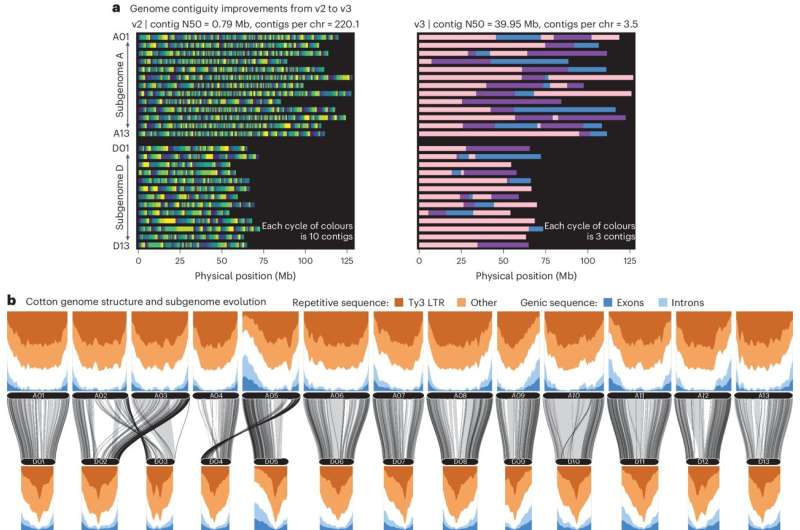This article has been reviewed according to Science X's editorial process and policies. Editors have highlighted the following attributes while ensuring the content's credibility:
fact-checked
peer-reviewed publication
trusted source
proofread
New genomic tools for three modern cotton varieties could guide future breeding efforts

We live in an ever-changing and growing world. Changing climates, emerging pests, and other environmental stressors put pressure on the cash crops that feed and fuel the world. As we race to meet the growing demand for sustainable and high-quality food and fiber crops, genomics is emerging as a powerful tool in the fight. By understanding plants' genetic codes, researchers and breeders can develop crops with increased yields, improved resistance to pests and diseases, and greater adaptability to environmental challenges.
Genome-informed breeding primarily benefits crops with existing high-quality genomic resources, like rice and wheat. However, crops with less mature genomic resources must continue to rely on traditional breeding methods, which sometimes suffer due to a lack of genomic diversity within the breeding populations.
Cotton, a vital cash crop worldwide, lacks robust genomic resources. The cotton industry is a big business, with a global economic impact of $600 billion and providing jobs for more than 250 million people. Successful cotton production relies on cotton varieties with desirable characteristics like high yield, good fiber quality, pest and disease resistance, and drought tolerance.
"Cotton breeders have improved fiber yield and quality over the years using traditional breeding methods," says Jeremy Schmutz, co-director of the HudsonAlpha Genome Sequencing Center, who has been working on cotton genomics for over a decade. "Achieving additional improvements may be difficult for them due to the lack of genetic variation across modern domesticated cotton. Creating new genomic tools for the industry will help take cotton improvements to the next level."
Scientists at the HudsonAlpha Institute for Biotechnology Genome Sequencing Center (GSC) and other collaborators set out to create high-quality genome sequences for three important cotton varieties, providing necessary genome resources for cotton breeders. The results were recently published in Nature Plants.
"Cotton research has relied heavily on one reference genome, 'TM1,' a variety of cotton that is no longer widely used in breeding programs," says Avinash Sreedasyam, Ph.D., first author of the manuscript. "In order for molecular breeding to benefit the cotton industry, many, varied genomes must exist to represent the diversity of cotton varieties. This study generated high-quality reference genomes for three modern upland cotton cultivars and updated the 'TM-1' cotton genetic standard reference."
Initial analysis of the new reference genomes produced important information about fiber quality. The highly accurate and complete genome assemblies were used to identify genetic material from Pima cotton (known for superior fiber quality) within modern cotton varieties. Small segments of each genome were compared to both Pima and the reference cotton genome.
Segments that matched Pima more closely than the reference cotton were classified as potential introgressions, suggesting Pima DNA had been incorporated into the modern cotton's genetic makeup. Knowledge of these Pima introgressions will help breeders to efficiently select progeny with these fiber-quality linked genetic markers in their breeding programs.
"Leveraging relatively inexpensive low-pass sequencing alongside these genomes empowers breeders to select progeny rapidly," says Sreedasyam. "This will not only save time but also reduce costs associated with traditional fiber phenotyping, a laborious process usually requiring hundreds to thousands of samples per breeding cycle."
These findings highlight the significance of using detailed genome assemblies to uncover genetic variations that can improve cotton breeding programs. The more these new, high-quality genomes are used for comparative studies, the more information about economically important cotton traits will emerge. The genomic resources described in this study represent a valuable addition to the cotton breeding toolkit and will reap benefits for years to come.
Collaborators on this project include Don C. Jones, Cotton Incorporated, NC; Peng W. Chee, University of Georgia, Tifton, GA; Warwick N. Stiller, CSIRO, Cotton Research Unit, Australia; and Fred Bourland, University of Arkansas, Keiser, AR.
More information: Avinash Sreedasyam et al, Genome resources for three modern cotton lines guide future breeding efforts, Nature Plants (2024). DOI: 10.1038/s41477-024-01713-z
Journal information: Nature Plants
Provided by HudsonAlpha Institute for Biotechnology





















